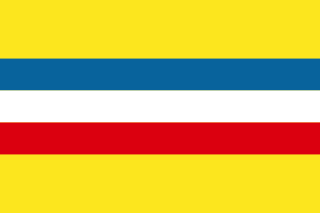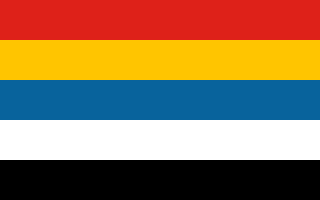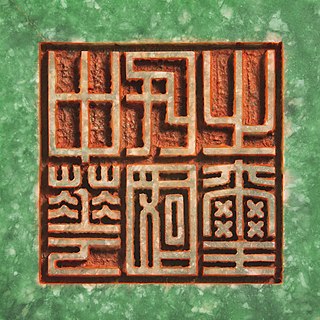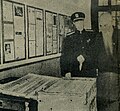
The president of the Republic of China, commonly known as the president of Taiwan is the head of state of the Republic of China (Taiwan) as well as the commander-in-chief of the Republic of China Armed Forces. The position once had authority of ruling over Mainland China, but its remaining jurisdictions has been limited to Taiwan, Penghu, Kinmen, Matsu, and other smaller islands since the conclusion of Second Chinese Civil War.

The Legislative Yuan is the unicameral legislature of Taiwan located in Taipei. The Legislative Yuan is composed of 113 members, who are directly elected for four-year terms by people of the Taiwan Area through a parallel voting system.

The National Assembly was the authoritative legislative body of the Republic of China, from 1947 to 2005. Along with the Control Yuan and the Legislative Yuan, the National Assembly formed the tricameral parliament of China. If still functional, at 3,045 members, the National Assembly would have been the largest parliamentary chamber in the world.

The Constitution of the Republic of China is the fifth and current constitution of the Republic of China (ROC), ratified by the Kuomintang during the Constituent National Assembly session on 25 December 1946, in Nanjing, and adopted on 25 December 1947. The constitution, along with its Additional Articles, remains effective in ROC-controlled territories.

The Control Yuan is the supervisory and auditory branch of the government of the Republic of China (Taiwan).
In Taiwan, parliamentary elections are held every four years to elect the 113 members of the Legislative Yuan, the unicameral legislature of Taiwan. The current electoral system was introduced in 2008. The constitutional amendments of 2005 extended term length from three to four years, reduced seat count from 225 to 113, and abolished the National Assembly, originally another governmental organ equivalent to a chamber of parliament.
There are eleven types of elections in Taiwan which, since 2012, have been unified into general and local elections, each held every four years, typically in January and November respectively. There may also be by-elections. Electoral systems include first-past-the-post, proportional representation, single non-transferable voting, and a parallel mixture of the above.

The free area of the Republic of China, also known as the "Taiwan Area of the Republic of China", "Tai-Min Area " or simply the "Taiwan Area", is a term used by the government of Taiwan to refer to the territories under its actual control.

The Nationalist government, officially the National Government of the Republic of China, also known as the Second Republic of China or simply as the Republic of China, refers to the government of the Republic of China from 1 July 1925 to 20 May 1948, led by the Kuomintang.

The Government of the Republic of China is the national government of Taiwan whose de facto territory currently consists of Taiwan, Penghu, Kinmen, Matsu, and other island groups in the "free area". Governed by the Democratic Progressive Party (DPP) since 2016, the president is the head of state. The government consists of the presidency and five branches (Yuan): the Executive Yuan, Legislative Yuan, Judicial Yuan, Examination Yuan, and Control Yuan.

The Young China Party (YCP), also known as the Chinese Youth Party (CYP), is a minor political party in Taiwan. It was one of the three legal political parties in Taiwan during the martial law period from 1949 to 1987, the other two being the Kuomintang and the China Democratic Socialist Party. The YCP was an important political party during the early history of the Republic of China, when its government was based on the mainland.

The China Democratic Socialist Party was a Chinese political party founded in Shanghai on 14 August 1946. It was formed through the merger of the former Chinese National Socialist Party and the Democratic Constitutionalist Party. The inaugural leader of the party was Carsun Chang. Along with the Kuomintang, the Young China Party and China Democratic League, it was one of the longest active political parties in both Nationalist China and in post-civil war rump Republic of China in Taiwan.
The Progressive Party was a political party in the Republic of China from 1913 to 1916.
The 1948 Chinese presidential election was held on April 20, 1948 at the National Assembly House in Nanking. The election was conducted by the National Assembly to elect the President and Vice President of China. This is the first election under the newly adopted 1947 Constitution of the Republic of China.
The 1947 Chinese National Assembly election was held between 21 and 23 November 1947 in China. This is the first election of under the newly ratified 1947 Constitution of the Republic of China. Under this constitution, the National Assembly is an authoritative legislature body that holds the power as constitutional convention and presidential electoral college. A total of 2,961 delegates were elected from across the country.

The Republic of China (ROC), or simply China (中國), was a sovereign state based in Mainland China from 1912 to 1949. It was first established in 1 January 1912, when it was proclaimed in the 1911 Revolution against the Manchu-led Qing dynasty, until 7 December 1949, after its ruling party Kuomintang (KMT) was defeated by the Chinese Communist Party (CCP) at the de facto end of the Chinese Civil War, which resulted in a retreat of its central government to Taiwan, a territory which it took control of from the Empire of Japan in October 1945 after its surrender in World War II. The CCP-led People's Republic of China (PRC) then took over the governance of Mainland China with its capital in Beijing upon its establishment in 1 October 1949, while the ROC is now based on the island of Taiwan with its capital in Taipei, where it retains actual rule over the Taiwan Area with the political status of Taiwan remaining in dispute to this day.

Indirect elections were held for the presidency and vice-presidency of the government of the Republic of China on Taiwan on March 21, 1960. The vote took place at the Chung-Shan Hall in Taipei. Incumbent President Chiang Kai-shek and Vice-President Chen Cheng was re-elected.

There are two National Seals of the Republic of China (中華民國國璽),, commonly known as the National Seals of Taiwan. The Seal of the Republic of China is the official seal of Taiwan.The Seal of Honour is used by the head of state in the conferring of honours.

The National Constituent Assembly was a constituent assembly in the Republic of China, assembled for drafting the Constitution of the Republic of China. Meetings were convened in November and December 1946 at National Great Hall, Nanjing.






























